

Worm kills insects by vomiting Hulk-like bacteria. Insects have been around for almost 400 million years.

What a way to go: prehistoric turtles died during sex - life - 20 June 2012. What a way to go.

Some 47 million years ago, these turtles clung to each other as they mated in a German lake. Now fossilised, the members of this species are the only known examples of vertebrates fossilised during copulation. Six-Legged Giant Finds Secret Hideaway, Hides For 80 Years : Krulwich Wonders... No, this isn't a make-believe place.

It's real. They call it "Ball's Pyramid. " It's what's left of an old volcano that emerged from the sea about 7 million years ago. A British naval officer named Ball was the first European to see it in 1788. It sits off Australia, in the South Pacific. What's more, for years this place had a secret. A satellite view of Ball's Pyramid in the Tasman Sea off the eastern coast of Australia. Toggle caption Google Maps Here's the story: About 13 miles from this spindle of rock, there's a bigger island, called Lord Howe Island. The snake whose bite can send you back through puberty. I'm sorry but I have to get on my soap box for just a sec...ahem* In response to your statement regarding snake and their bites killing people in the second paragraph, "That's unpleasant, but we already knew that about most snake bites.

" As a conservationist, nature boy, amateur herpetologist and all-around good guy, I must protest the implication in that sentence. Dear Deeplings: I thought I was a plant, but now I think I’m a killer! AHHHH!
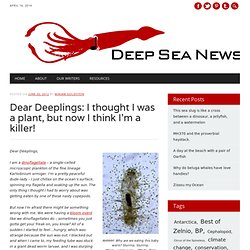
Why are we eating this baby worm? Slurrrrp. Slurrrrp. Mmm...worm juice... (Photo: Terje Berge/International Society for Microbial Ecology Journal) Mammals Made By Viruses. If not for a virus, none of us would ever be born.
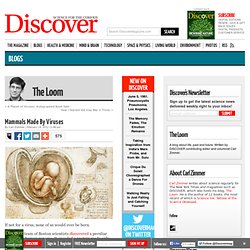
In 2000, a team of Boston scientists discovered a peculiar gene in the human genome. It encoded a protein made only by cells in the placenta. Forget fittest, it's survival of the most cultured. David Sloan Wilson, contributor Evolutionary biologist Mark Pagel enters tricky terrain to argue that social structures are key to human evolution in Wired for Culture FOR decades, proponents of the power of culture in human development have been tribal enemies of those who champion the power of evolution.
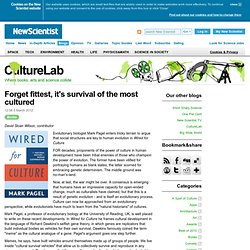
The former have been vilified for portraying humans as blank slates; the latter scorned for embracing genetic determinism. The middle ground was no-man's-land. Now, at last, the war might be over. Mark Pagel, a professor of evolutionary biology at the University of Reading, UK, is well placed to write on these recent developments. Memes, he says, have built vehicles around themselves made up of groups of people. Wired for Culture explores the implications of the emerging consensus across the breadth of human experience, from religion, the arts and economics, through consciousness, deception, conflict and the very idea of truth.
Why do women menstruate? Menstruation is a peculiar phenomenon that women go through on a roughly monthly cycle, and it’s not immediately obvious from an evolutionary standpoint why they do it.
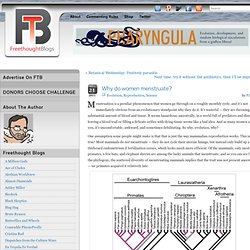
It’s wasteful — they are throwing away a substantial amount of blood and tissue. It seems hazardous; ancestrally, in a world full of predators and disease, leaving a blood trail or filling a delicate orifice with dying tissue seems like a bad idea. Giant living power cables let bacteria respire - tech - 29 June 2012. IT IS the ultimate in subsea communications: bacteria living in sulphurous mud beneath the seabed respire by transforming themselves into long, insulating cables and shuttling electrons from one to another.
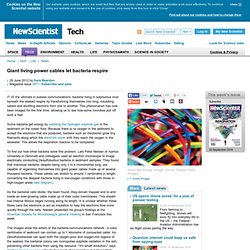
This phenomenon has now been imaged for the first time, allowing us to see how some microbes pull off such a feat. Some bacteria get energy by oxidising the hydrogen sulphide gas in the sediment on the ocean floor. Because there is no oxygen in the sediment to accept the electrons that are produced, bacteria such as Geobacter grow tiny filaments along which the electrons travel until they reach the oxygen in the seawater. This allows the respiration reaction to be completed. To find out how other bacteria solve this problem, Lars Peter Nielsen of Aarhus University in Denmark and colleagues used an electron microscope to image electrically conducting Desulfobulbus bacteria in sediment samples. New Scientist Not just a website! More From New Scientist Promoted Stories Recommended by. Eat me baby: wooing the sagebrush cricket way. Sally Adee, features editor Imagine if every time you wanted to have sex you had to get bitten by a shark.
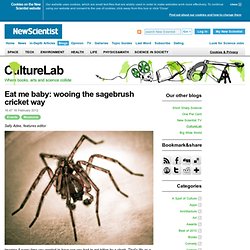
That's life as a shark. But the graphic pictures of the fin-ripping aftermath of a shark “romp” were far from the worst thing I saw on Tuesday night at the Valentine’s-themed night safari at London's Natural History Museum. There were two tracks; you could choose between the Turn Me On and Turn Me Off tour. Having already been thoroughly turned off by a month of exploitative Valentine’s day adverts, I chose the latter.